I stand to be corrected on this, but this upcoming TV series, scheduled to appear on AMC+ sometime next year, takes place in early 1960s France, where PI Ssm Spade has recently retired. Until now, that is, when he’s called upon to tackle another case of murder and maybe more. I can’t tell more than that from the trailer below, but it does star Clive Owen as Sam Spade, so there is that.
November 2023
Thu 16 Nov 2023
TV Trailers I’m Watching: MONSIEUR SPADE (2024).
Posted by Steve under Movie & TV Trailers[8] Comments
Wed 15 Nov 2023
ELLIOTT CHAZE – Wettermark. Scribner’s Sons, hardcover, 1969. No paperback edition.
Cliff Wettermark is a reporter at shitty small town Mississippi paper.

His life sucks. He can’t pay his bills. It’s just doldrums. Day after day of mediocrity and the slow bleed of failure.
Then something happens. A guy robs the town bank.
He just drives right up to the drive thru, hands the teller a note that says: ‘Gimme all your money. Rifles are trained at your head. Don’t hesitate. Give me all of the bills in your till immediately or you will be dead two seconds after I honk my horn.’ And she does. Hands him $10,000.
It was that easy.
Wettermark can’t let it go. He dreams about it.
In a dream, he speaks with the robber:
“The sunglasses were the blackest kind of black and very large, bulging like grasshopper eyes. The robber’s voice seemed to come from behind the glass, his mouth not moving at all. He had asked Wettermark how long it had been since Wettermark lived a really good day or night. Wettermark said he couldn’t remember but it was probably on furlough from Fort Benning in War II. The robber said was the trouble with everybody. They kept hoping for a string of good years; but while they were waiting, they didn’t live one good day and many didn’t have even a single fine hour. The robber said people were tricked by the lure of longevity, yet there was no crueler death than that of extreme old age and a hundred years would mean nothing if the span was composed of thousands of rotten, meaningless days. The robber invited Wettermark to examine the fabric of the past year and then state one clear reason for not taking the risk of robbing a bank. It was all a matter of logic. A man needed money in quantity. A glimpse of the green was not enough. The money was in the bank. It was not much of a gamble if the life you were living was drab.”
Wettermark puts the dream aside, and continues his dull, boring life.
He starts drinking again. And he’s assigned to a Senator’s press conference at the local college. He’s not paying much attention. Then the senator says, about the Vietnam war: “I believe some excellent reporting is being done over there; but at times the Pentagon paints too rosy a picture of the supply situation. That, of course, is all a part of the war, you don’t know your own side.”
Wettermark, drunk, and drunk sick of the mendaciousness of it all, “was surprised to hear himself saying: ‘Why the hell shouldn’t you knock it if your side does something wrong?'”
“The senator smiled at him, the tawny face as pleasant and relaxed as before. ‘Are there any more questions?'”
“‘I asked you a question,’ said Wettermark.”
“The TV reporter who looked like a Pekingese, whom Wettermark had not seen since the bank robbery, dropped his pencil. While he was bent over the side of his chair, he hit Wettermark on the leg and hissed: ‘This is a live interview, you creep.'”
“Wettermark said to the senator who held onto the smile: ‘Tell me, sir, tell me in living color, if you would want to pile on the pressure if it was your ass over there in the jungle?'”
“The TV reporter made a slashing gesture at the camera-man behind him and Wettermark arose from his seat, bowed to the assembly, a kind of half-bow. He hoped that his smile was faint and mocking. His head hurt and he knew he was going to be sick.”
Wettermark is immediately fired. And now he really is screwed. His wife leaves him, he can’t pay his bills, he’s got no career prospects but one: Bank robber.
So he plots. And he plots. And he does it.
The first half of the book is a straight tale of the boring life of a small town police reporter. A tale that Chaze knew personally and well.
The second half is a caper novel. Pulled off by someone with the skills of a Dortmunder. But it’s no joke from here on out.
It’s real and it’s frightening and it’s…..well I don’t wanna tell you how it ends. But anyone who has read Black Wings Has My Angel knows that Chaze knows how to plot and write vividly of violence and of crime gone awry.
In its own way, once the caper starts the novel is fully the equal of Black Wings. Which is saying a lot. Because Black Wings may be the best caper novel of all. But while Black Wings is dirty and swampy and belongs on a shelf with Whittington and Charles Williams and Jim Thompson — this one reads like the book of a completely different writer.
The book credibly sounds like the voice of a near-do-well reporter who decides to rob a bank. Which is what it is. He’s educated. He’s cynical. He’s dissatisfied. And he’s incompetent and nervous. Just like you and me. Or me, at least.
It’s a really good book that deserves to be in print.
Another review here: https://neglectedbooks.com/?p=286
Sat 11 Nov 2023
I’m going to be taking a few days off from posting on this blog. A lot of personal matters that need to be taken care of are to blame. I can’t tell you for sure when I’ll be back, but I’ll keep you posted when I know a lot more, especially if I have to be away longer than I think I’ll be now. I’ll be back when I can!
Thu 9 Nov 2023
An Archived Mystery Review by BILL CRIDER – Winning Can Be Murder.
Posted by Steve under Reviews[4] Comments
BILL CRIDER – Winning Can Be Murder. Dan Rhodes #8. St. Martin’s, hardcover, 1996. Worldwide, paperback, 2000.

This is my favorite of Bill’s series, and it’s a sin and a shame that no one is doing them in paperback now. Other people try to do small town Southwestern cop novels and some do pretty good, but nobody does them as well as Bill.
Do you know what small-town Texas tragedy is? It’s having an assistant coach murdered just when the local high school football team is about to make the playoffs for the first time in ages. Do you know what pressure is? It’s what Sheriff Dan Rhodes feels from every citizen of the surrounding territory above the age of five (and a few below it) to solve this crime and get it out of the way so folks can get back to worrying about really important matters-like a football game.
I don’t have any first-hand experience with small-town high school football these days, so I can’t say whether Bill nailed it present-day or not; I can say that it it was that way when I experienced it, and I could smell the dust and hear the cheers again when I read his descriptions.

Aside from Bill’s always smooth and easy-to-read prose, that’s what l enjoy most about the books — the feeling that these are real people in real places, acting the way people in those places act. Well, up to a point, anyway.
The Rhodes books will never b5e huge sellers, because they aren’t grim and bloody enough to attract the body-count crowd, nor on the other hand a female lead who can tumble “engagingly” into peril, save the police from their incompetence, and give you a to-die-for recipe in the process.
They are nevertheless thoroughly entertaining and very readable, and it’s a damned shame more people don’t know about them.
Wed 8 Nov 2023
Reviewed by Mike Tooney: ERLE STANLEY GARDNER – The Exploits of the Patent Leather Kid.
Posted by Steve under Characters , Pulp Fiction , Reviews[2] Comments
ERLE STANLEY GARDNER – The Exploits of the Patent Leather Kid. Crippen & Landru Publishers, 2010. Edited and introduced by Bill Pronzini. 13 stories.
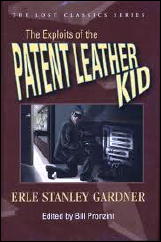
When most people hear the name Erle Stanley Gardner, they immediately think of his most famous character creation, Perry Mason, but he was also an incredibly prolific pulp fiction writer. One of the characters Gardner created for the pulps was The Patent Leather Kid, an unoriginal amalgamation of Zorro, Raffles the Gentleman Thief, and The Scarlet Pimpernel.
Gardner’s principal contribution to this style of hero — the effete, indolent society fop he pretends to be while his alter ego tirelessly fights criminals and the official authorities when necessary — was to infuse his stories with the hardboiled sensibilities of Depression Era America. Even so, Gardner never let his Patent Leather Kid’s exploits veer into sadism: The Kid was always on the side of right, and the reader knew it.
Thanks to Doug Greene at Crippen & Landru for bringing back The Patent Leather Kid and other pulp heroes from their undeserved oblivion.
The stories: [All originally published in Detective Fiction Weekly.]
(1) “The Kid Stacks a Deck” (1932): A local criminal gang really has it in for The Patent Leather Kid and sets up an ambush. The Kid, meanwhile, sets out to prove that robbing a jewelry store equipped with the most up-to-date alarm systems isn’t, as the store’s owner boasts, “impossible” after all.
(2) “The Kid Passes the Sugar” (1932): Someone’s gunning for The Kid but kills the wrong person. The Kid sets a trap with a shiny platinum watch as bait and an abused wife as a means of bringing the killer to justice.
(3) “The Kid Wins a Wager” (1932): The Patent Leather Kid sets out to help a woman in trouble with her boss, only to come up against another burglar who’s quite capable of framing The Kid for his own crimes. If he’s clever enough, The Kid might be able to escape the frame — and collect a large bet in the bargain.
(4) “The Kid Throws a Stone” (1932): Somebody’s running around pretending to be The Patent Leather Kid, pulling off robberies in fancy Chryslers and making no effort to be subtle about it. The Kid must lay a trap for his doppelganger that, if successful, will not only clear him with the police but also aid a distressed damsel he’s never met.
(5) “The Kid Makes a Bid” (1933): After several attempts at robbing a jewelry store, a thief apparently succeeds, taking some stones and cash with him and leaving two of the store’s assistants hog-tied with ropes and handcuffs. The Kid’s suspicions are aroused by the way the crime was committed, and he performs a rough “experiment” on an unscrupulous businessman, thereby thwarting two crimes simultaneously.
(6) “The Kid Muscles In” (1933): A doctor is murdered, and the prime suspect — a young man in love with the victim’s niece — can’t explain away his presence at the crime scene or his fingerprints on the murder weapon. It falls to The Patent Leather Kid to exonerate the falsely-accused in the way he knows best, breaking and entering with intent to catch the real bad guys.
(7) “The Kid Takes a Cut” (1933): An ex-con gets the blame for a jewel robbery he didn’t commit. His alibi — that a woman gave him the stones as a reward for a good deed — is, let’s be frank, flimsy at best. Only the ex-con’s wife can corroborate his story, but the police won’t believe a word of it. The Kid must contrive an elaborate scheme involving matching train schedules to prove the man innocent, for otherwise the real thieves will soon be on their merry way.
(8) “The Kid Beats the Gun” (1933): A famous — and vastly overrated — criminologist fingers the butler of a rich couple as the one who stole valuable jewels from them. The butler finally confesses, not to the theft, but simply to following orders. The Patent Leather Kid must intervene to prevent a miscarriage of justice and experiences the triple satisfaction of exposing a fraud, deflating an egomaniac’s pomposity, and seeing an innocent man cleared.
(9) “The Kid Covers a Kill” (1933): The man often referred to as The King of the Underworld operates almost entirely with impunity, unhindered by the police. To him, the lives of his victims don’t mean very much. But when he brutally murders the sister of one of his underlings, The Patent Leather Kid gets involved — and for The King of the Underworld, that’s a very unhealthy development.
(10) “The Kid Clears a Crook” (1934): A small businessman with a criminal record tries to go straight but runs afoul of organized crime; they get him framed for a jewelry theft — enough of an injustice to attract The Kid’s indignant notice. Before it’s all over, The Kid will have fenced some hot ice, dodged numerous submachine gun bullets, and tickled a butler.
(11) “The Kid Clips a Coupon” (1934): A wealthy elderly woman has been murdered — by a tramp, according to the police — but The Kid doesn’t think so. The whole thing smacks of an inside job — a case of discovered embezzlement — and The Kid must be proactive to head off another murder, even if it means kidnapping someone himself.
(12) “The Kid Cooks a Goose” (1934): The underworld and the police have a common nemesis — and common cause to rid themselves of him — namely The Patent Leather Kid. The cops have let it be known — through unofficial channels, sub rosa, you understand — that if the criminal class terminates The Kid, they’re willing to cut the crooks some slack. When The Kid receives news of this ad hoc arrangement to bump him off, it’s without joyful enthusiasm. His characteristic response is to devise an impromptu plan that will not only clear him of a murder frame, neutralize several underworld kingpins, and save a woman’s life, but also give a guinea pig his big chance to be a crime buster.
(13) “The Kid Steals a Star” (1934): During the course of a robbery at a jewelry store, a policeman is killed and the night watchman gets the blame. It gets worse for him when he foolishly tries to skip town; actually, he’s been perfectly framed by the clever boss of a criminal gang. In order to clear the watchman and catch the crime boss in the act of swindling a jeweler, The Kid, with the able assistance of his bodyguard and an admiring telephone operator, must concoct a three-act “play” starring gangsters, gemstones, guns, and — if everything goes according to plan — a happy ending.
Random notes:
Unlike Sherlock Holmes, The Kid does see it as his duty to correct the deficiencies of the official police. — All of the members of the gentlemen’s club are stereotypes. — Gardner always uses the word “conservative” with negative connotations. — These stories aren’t mysteries in the traditional sense: The fun is watching The Kid improvising his way out of tight situations. — There’s a lot of 1930s gangster slang. — The reader shouldn’t try to read more than one story at a time: Gardner was clearly writing to a formula. Read one every few days to avoid tedium.
For even more about The Patent Leather Kid, see Monte Herridge’s Mystery*File article here: https://mysteryfile.com/blog/?p=13823.
Tue 7 Nov 2023
Diary Mystery Review: ELLERY QUEEN – What’s in the Dark?
Posted by Steve under Diary Reviews[2] Comments
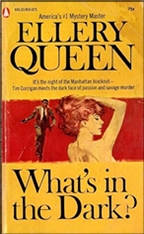
ELLERY QUEEN – What’s in the Dark? Capt. Tim Corrigan #6. Popular Library, paperback original; 1st printing, 1968. Dale Books, paperback, 1978. Zebra, paperback, 1985.
Captain Tim Corrigan is assigned to a murder case on the night of New York City’s “Great Blackout.†The suspects are all trapped on the 21st floor with the body while Corrigan’s investigation goes on. And of course the blackout helps provide the means for establishing the killer’s guilt.
The psychology of crumbling inhibitions is emphasized, but Corrigan and his detective pal Chuck Baer still have too great a tendency to climb into bed with their suspects. That and an early emphasis on Miss Graves’ mammae make this novel [considerably] different from EQ’s more conventional mysteries.
[It’s] strictly enjoyable, though, and the reader has a fair chance to grab the essential clue on page 45. I shall look for more. [Books in the series, that is, not clues. per se.]
Rating: ***½
UPDATE: Reading this old review tonight for the first time in 55 years, it does not appear that back when wrote it I knew that the book was not written by “Ellery Queen.” It was ghost-written instead by Richard Deming, who as it turns out was the actual author of four of the overall six Tim Corrigan novels.
Mon 6 Nov 2023
A TV PI Mystery Review: BOURBON STREET BEAT “A Taste of Ashesâ€.
Posted by Steve under Reviews , TV mysteries[6] Comments

BOURBON STREET BEAT. “A Taste of Ashes.†ABC, 05 October 1959 (Season 1, Episode 1). Richard Long (Rex Randolph), Andrew Duggan (Cal Calhoun), Arlene Howell (Melody Lee Mercer), Van Williams (Kenny Madison). Guest Cast: Joanna Moore, Fredd Wayne, Karl Weber, Isobel Elsom, Jean Byron, Jean Allison. Based on the novel by Howard Browne. Director: Leslie H. Martinson. Currently streaming online here.
When you’re a private detective and your partner is murdered, you’re obliged to do something about it. Especially when the local cop tells you it’s suicide and you know it’s not. Such is the case that Rex Randolph (Richard Long) finds himself on, taking over from the one that his partner, a chap named Jelkens, was working on.
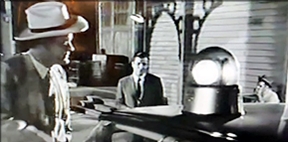
Randolph’s office is in New Orleans (not Chicago, as in the book), but most of the action takes place in Pelican Point, a town run by a wealthy matriarch who doesn’t want certain information made public. Blackmail is a nasty business, but the head cop doesn’t want Randolph or any of his assistance anywhere around. An older man on the force, tired of working under younger fellows, is a lot of more sympathetic, and I hope I don’t spoil anything for anybody by telling you that this older guy is named Cal Calhoun (Andrew Duggan), who by episode’s end is Randolph’s new partner.
There is a noirish vibe in this episode – well, why not, being set in New Orleans and close environs as it is – that’s less present in contemporary stablemate Surfside 6, say, or even 77 Sunset Strip. at least this time around.
The book is still better, though, a well-recognized masterpiece in the hardboiled/PI/noirish vein. (For Bill Pronzini’s 1001 Midnights review of the book, go here.)

Sun 5 Nov 2023
Reviewed by David Vineyard: PAMELA FRANKAU – Colonel Blessington.
Posted by Steve under Reviews[5] Comments
PAMELA FRANKAU – Colonel Blessington. [Completed by Diana Raymond.] Bodley Head, UK, hardcover, 1968. Delacorte, US, hardcover, 1969. Dell 1378, US, paperback, 1970.

And well he might. Harvey Blessington is many things to many people. To most he is a war hero, the brave Colonel Blessington, to Anthony Price he is the man who ought to replace the candidate for Parliment they both support, to actress Anita Gilroy he is object of her first love, and to her father Matthew, he is his ex-commando comrade in arms and the object of an obsessive memory a nightmare running “like a dark river underground, until he also becomes the object of fear and a mystery that remains unsolved.”
Like quicksilver Harvey Blessington seems always changing shape, sometimes a shadow, sometimes bright as the sun, sometimes dark and strangely threatening. At the heart of Harvey Blessington is a mystery, one just beyond belief, at once revealing and impossible to believe.
One worth men’s lives to keep hidden.
Colonel Blessington was the final novel by British novelist Pamela Frankau, and her first suspense novel venturing into the kind of duality and uncertainty of a Graham Greene or Patrica Highsmith. Frankau grew ill and died while writing the book and her friend novelist Diana Raymond finished the book from her extensive notebooks. While the novel was recognized in its time and critically praised in both Britain and here, her death perhaps overshadowed the novel which isn’t half as well known as it once was.
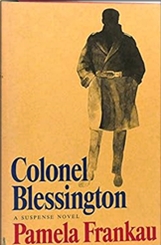
Frankau was the daughter of British literary gadabout Gilbert Frankau, who abandoned her and her mother when she was small. She went on to become a famed and critically praised novelist on her own, her some sixteen novels such as A Wreath for the Enemy, Over the Mountain, and Clothes of a King’s Son, among her better known works.
As Matthew Gilroy finds himself hunted and hunter going to ground to uncover the enigma of Blessington, the tension ratchets up and the need to solve the mystery of Harvey Blessington a matter of life and death.
Why?
You were the man who killed beside me in the war, all those years ago, But — to kill me for that? You were so sure you would kill me you boasted of another murder; of a girl that haunted you… Why?
Blessington is something of a tour-de-force, pulling off a twist worthy of Agatha Christie. It’s one of those books that cleverly lays the groundwork for its key revelation so you can look back and see each clue and misdirection, yet has a solution so shocking that you won’t guess it ahead of time, Blessington’s ultimate flaw “…to take people’s lives and spoil them — a love of power. A common love brought to extremes —â€
I first read Colonel Blessington when it came out back in 1968. It still holds up today, its final revelation still as stunning and chilling as it was then, its quiet shocks coming with a chill to the bone and a recognition of our own prejudices and blindness when we fail to see the obvious right in front of us and recognize the duplicitous Blessingtons in our own lives.
Sat 4 Nov 2023
A PI Mystery Review by Tony Baer: O. G. BENSON – Cain’s Woman.
Posted by Steve under Reviews[7] Comments
O. G. BENSON – Cain’s Woman. PI Max Raven #1. Dell First Edition A200, paperback original; 1st printing, 1960. Perennial Library, paperback, 1985, as Cain’s Wife.
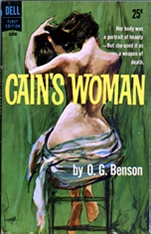
So I figured there’s gotta be something biblical with the Cain’s Woman thing, right? From what I can tell by googling, it looks like the biblical Cain married his twin sister. If you google ‘Cain’s Wife’, the first thing that comes up is a Wikipedia (yes, know—Wikipedia isn’t reliable; at the same time, I’m not in the mood to do serious research at on this and the results confirm my confirmation bias) entry that says:
“According to the Book of Jubilees, Awan (also Avan or Aven, from Hebrew ×ָוֶן aven “vice”, “iniquity”, “potency”) was the wife and sister of Cain and the daughter of Adam and Eve.”
So, there’s that.
Mrs. Cain doesn’t disappoint. Vice, iniquity, potency? She’s got ’em.
And she comes to call on our lonely detective in his lonely beat down office, wanting his help.
The detective is Max Raven. And he’s everything the well-dressed private detective ought to be, to coin a phrase. Except for the well-dressed part.

Mrs. Cain says she’s being blackmailed as a result of some naughty candid pictures her ex-fiancé took of her. Mr. Cain is very old and very rich and proper. And it wouldn’t do at all for him to see these photos. Would Raven please please please fetch them for her.
And he does.
But things aren’t what they appear to be, and Mrs. Cain is both far more and far less than she appears. She plays Raven like a fiddle, and gives him fits, til he’s fit to be tied, like sudden death. And like sudden death, it comes. Suddenly.
The book is quite good, Raven is likable, Mrs. Cain is femme-fatale-able. Til the end, which is far too fallible for a femme fatale to be.
That is to say, O.G. Benson plays nary a note wrong. Until the end. When his femme-fatale does something that no femme-fatale can do, nor has ever done. It’s a fatale flaw. It takes a tale that was just a step away from being as good or better than Charles Williams’s Touch of Death and ruins it. At the very last second. Like gluing a hallmark card onto Munch’s The Scream. I screamed.
Or what’s worse. I didn’t.
A more favorable review here: https://vinpulp.blogspot.com/2008/02/cains-woman-by-o-g-benson.html
Fri 3 Nov 2023
An Archived PI Mystery Review by Barry Gardner: LES ROBERTS – Collision Bend.
Posted by Steve under Reviews[2] Comments
LES ROBERTS – Collision Bend. Milan Jacovich #7. St. Martin’s. hardcover, 1996. No paperback edition.
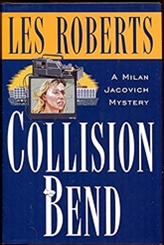
You know by now that I think Les Roberts is one of the better and certainly one of the more underrated PI writers around today. It appears that he’s decided to let his Saxon series languish and concentrate on Cleveland PI Milan Jacovich, and that suits me just fine. Les gives really good Cleveland.
Milan Jacovich encounters that hoariest of PI cliches, a visit from an old love, one from whom the parting was painful and the wound slow to close. A television journalist at the station where she works has been murdered, and the man for whom she left Jacovich is under suspicion. Even worse, he was having an affair with the dead woman.
But she wants Milan to prove him innocent, and she knows that the moral code that drove them apart will make him do everything in his power to help the man — if he takes the case. He knows he shouldn’t, but he does; and even before the last shot is fired he realizes that his first inclination was the right one.
You’d think reviewing a book you like by an author you like is about as easy as it gets for a reviewer, wouldn’t you? Well, maybe not. When it’s an author you’ve reviewed many times before, there’s a tendency to run out of new things to say, or any fresh ways to say them, and that’s where I am with Les Roberts.
He still writes immensely readable prose; still makes of the City of Cleveland a colorful and likable character in itself; still writes about a strong, capable, but intensely human and fallible human being in Milan Jacovich; and is still as good at characterization as anyone around.
But you’ve already heard all that from me, right? So why don’t I just reiterate that the man writes really good books, and that this is one of them? Okay. Done.